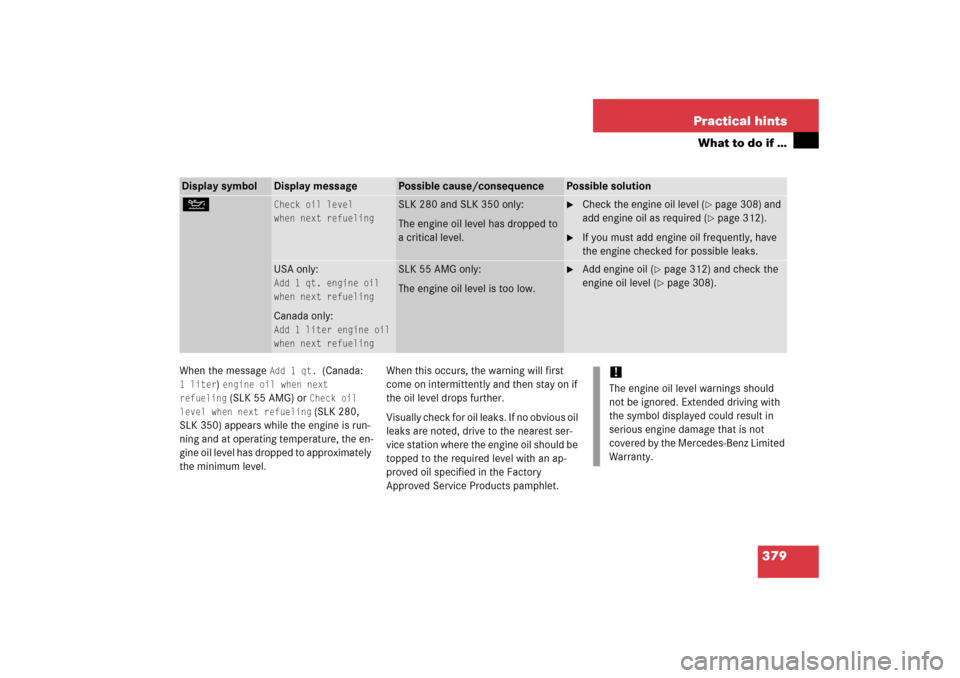Page 354 of 481

353 Operation
Vehicle care
�Vehicle care
Cleaning and care of vehicle
While in operation, even while parked, your
vehicle is subjected to varying external in-
fluences which, if gone unchecked, can at-
tack the paintwork as well as the
undercarriage and cause lasting damage.Such damage is caused not only by ex-
treme and varying climatic conditions, but
also by:
�
Air pollution
�
Road salt
�
Tar
�
Gravel and stone chipping
To avoid paint damage, you should imme-
diately remove:
�
Grease and oil
�
Fuel
�
Coolant
�
Brake fluid
�
Bird droppings
�
Insects
�
Tree resins, etc.
Frequent washing reduces and/or elimi-
nates the aggressiveness and potency of
the above adverse influences.More frequent washings are necessary to
deal with unfavorable conditions:
�
near the ocean
�
in industrial areas (smoke, exhaust
emissions)
�
during winter operation
You should check your vehicle from time to
time for stone chipping or other damage.
Any damage should be repaired as soon as
possible to prevent corrosion.
In doing so, do not neglect the underbody
of the vehicle. A prerequisite for a thor-
ough check is a washing of the underbody
followed by a thorough inspection. Dam-
aged areas need to be re-undercoated.
Your vehicle has been treated at the facto-
ry with a wax-base rustproofing in the body
cavities which will last for the lifetime of
the vehicle. Post-production treatment is
neither necessary nor recommended by
Mercedes-Benz because of the possibility
of incompatibility between materials used
in the production process and others ap-
plied later.
Warning!
G
Many cleaning products can be hazardous.
Some are poisonous, others are flammable.
Always follow the instructions on the partic-
ular container. Always open your vehicle’s
doors or windows when cleaning the inside.
Never use fluids or solvents that are not de-
signed for cleaning your vehicle.
Always lock away cleaning products and
keep them out of reach of children.
Page 380 of 481

379 Practical hints
What to do if …
When the message
Add 1 qt.
(Canada:
1 liter
) engine oil when next
refueling (SLK 55 AMG) or
Check oil
level when next refueling (SLK 280,
SLK 350) appears while the engine is run-
ning and at operating temperature, the en-
gine oil level has dropped to approximately
the minimum level.When this occurs, the warning will first
come on intermittently and then stay on if
the oil level drops further.
Visually check for oil leaks. If no obvious oil
leaks are noted, drive to the nearest ser-
vice station where the engine oil should be
topped to the required level with an ap-
proved oil specified in the Factory
Approved Service Products pamphlet.
Display symbol
Display message
Possible cause/consequence
Possible solution
N
Check oil level
when next refueling
SLK 280 and SLK 350 only:
The engine oil level has dropped to
a critical level.
�
Check the engine oil level (
�page 308) and
add engine oil as required (�page 312).
�
If you must add engine oil frequently, have
the engine checked for possible leaks.
USA only:Add 1 qt. engine oil
when next refuelingCanada only:Add 1 liter engine oil
when next refueling
SLK 55 AMG only:
The engine oil level is too low.
�
Add engine oil (
�page 312) and check the
engine oil level (�page 308).
!The engine oil level warnings should
not be ignored. Extended driving with
the symbol displayed could result in
serious engine damage that is not
covered by the Mercedes-Benz Limited
Warranty.
Page 381 of 481
380 Practical hintsWhat to do if …Display symbol
Display message
Possible cause/consequence
Possible solution
N
Engine oil level
Stop, engine off
SLK 55 AMG only:
There is no oil in the engine. There
is a danger of engine damage.
�
Carefully bring the vehicle to a halt as soon
as possible.
�
Turn off the engine.
�
Add engine oil (
�page 312) and check the
engine oil level (�page 308).
Engine oil level
Visit workshop
SLK 55 AMG only:
The measuring system is malfunc-
tioning.
�
Have the measuring system checked by an
authorized Mercedes-Benz Center.
Engine oil level
Reduce oil level
SLK 55 AMG only:
You have added too much engine
oil. There is a risk of damaging the
engine or the catalytic converter.
�
Have oil siphoned or drained off.
Observe all legal requirements with respect
to its disposal.
Engine oil
Visit workshop
SLK 55 AMG only:
There may be water in the engine
oil.
�
Have the engine oil checked.
Page 403 of 481

402 Practical hintsReplacing bulbs
Notes on bulb replacement�
Only use 12-volt bulbs of the same type
and with the specified watt rating.
�
Switch lights off before changing a bulb
to prevent short circuits.
�
Always use a clean lint-free cloth when
handling bulbs.
�
Your hands should be dry and free of oil
and grease.
�
If the newly installed bulb does not
come on, visit an authorized
Mercedes-Benz Center.Have the LEDs and bulbs for the following
lamps replaced by an authorized
Mercedes-Benz Center:
�
Additional turn signal lamps in the
exterior rear view mirrors
�
Bi-Xenon* lamps
�
Front fog lamps
�
High mounted brake lamp
�
Brake lamps
�
Front and rear side marker lamps
�
Parking/standing lamps in the tail
lamp assemblies
Warning!
G
Bulbs and bulb sockets can be very hot. Al-
low the lamp to cool down before changing
a bulb.
Keep bulbs out of reach of children.
Halogen lamps contain pressurized gas.
A bulb can explode if you:�
touch or move it when hot
�
drop the bulb
�
scratch the bulb
Wear eye and hand protection.
Because of high voltage in Xenon lamps, it is
dangerous to replace the bulb or repair the
lamp and its components. We recommend
that you have such work done by a qualified
technician.
iHave the headlamp adjustment
checked regularly.
Page 469 of 481

468 IndexDriver’s door
Locking in an emergency 395
Unlocking in an emergency 394
Driving 53
Automatic transmission* 53
Driving off 296
Fuel saving 293
Hydroplaning 297
In winter 299
Instructions 47, 293
Manual transmission 53
Standing water 300
Tires 297
Traveling abroad 301
Driving safety systems 82
ABS 82
BAS 83
ESP
®
84E
Easy-entry/exit feature* 43, 148
Electric air pump 391
Electric air pump (Vehicle tool kit) 388
Electrical system (Technical data) 446
Electronic Stability Program see ESP
®
Emergency call (911) 243
Emergency call system 273
Tele Aid 275
Emergency operations
Automatic transmission* 172
Releasing trunk lid from inside 100
Remote door unlock (Tele Aid) 280
Retractable hardtop 397
Selector lever*, unlocking
manually 396
Unlocking/locking the vehicle 394
Emergency tensioning device see ETD
Emission control 302, 436
Engine
Cleaning see Vehicle care
Compartment 307
Driving after replacement 292
Number 436, 458
Technical data 438
Turning off 61Engine oil 308, 451
Adding 312
Additives 451
Checking level (Control system) 309
Checking level (Dipstick) 311
Consumption 308
Display message 310
Viscosity 458
ESP
®
84, 458
Display message 371
Warning lamp 365
ETD 73, 74, 459
Safety guidelines 68
Seat belt force limiter 74
Exterior lamp switch 110
Exterior lighting
Lamps 401
Replacing bulbs 401
Exterior rear view mirrors see Mirrors
Page 477 of 481

476 IndexT
Tachometer 121
Tail lamps 401
Tar stains see Vehicle care
TDMA or CDMA network phones
(Telephone*) 236
Technical data
Air conditioning refrigerant 451
Brake fluid 451
Coolants 453
Electrical system 446
Engine 438
Engine oil 451
Fuel additives 453
Fuel requirements 452
Fuels, coolants, lubricants, etc. 449
Headlamp cleaning system* 456
Main dimensions 447
Parts service 434
Premium unleaded gasoline 452
Rims and tires 439
Weights 448
Windshield washer system 456Tele Aid system 273, 462
Call priority 279
Initiating an emergency call 276
Remote door unlock 280
Requirements 273
Roadside Assistance 277
Stolen Vehicle Recovery
services 280
System self-check 274
Telephone* 272
Compartment 266
GSM network phones 229
Operation 151, 203
Tightening torque 462
Wheel bolts 419
Time and date synchronization with head
unit* (Control system) 139
TIN 346
Tire and Loading Information 321
Tire and loading terminology 344
Tire care and maintenance 318
Tire Identification Number see TINTire inflation pressure 410
Air pressure 344
Checking 327, 329
Tire inflation pressure see the placard on
the fuel filler flap
Tire inspection 318
Tire load rating 346
Tire ply composition and material
used 346
Tire speed rating 336, 346
Tire terminology 344
TIREFIT kit* (Vehicle tool kit) 388, 389
TIREFIT*
Instructions for use 408
Tires 317, 439
Cleaning 319
Collapsible (Spare wheel) 458
Direction of rotation 320
Driving instructions 297
Flat tire 408
Important guidelines 317
Inflating with air pump 417
MOExtended system* 333
Mounting wheel 415